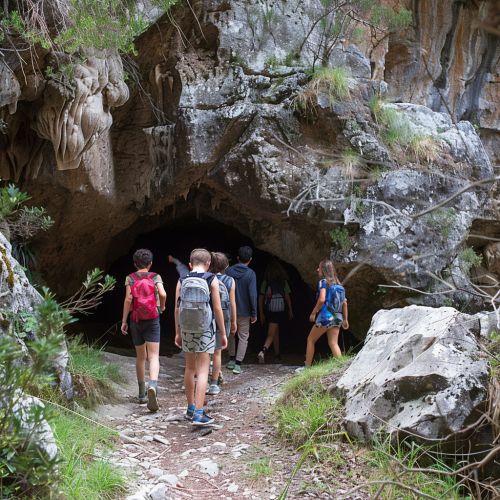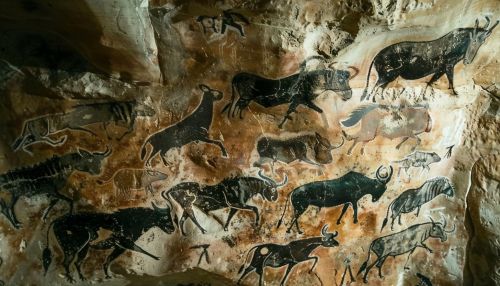Lascaux
Introduction
Lascaux is a complex of caves located in southwestern France, near the village of Montignac in the Dordogne region. The caves are renowned for their Paleolithic cave paintings, which are estimated to be over 17,000 years old. These paintings represent some of the finest examples of art from the Upper Paleolithic period, showcasing a high degree of sophistication and detail.
Discovery
The Lascaux caves were discovered on September 12, 1940, by four teenagers - Marcel Ravidat, Jacques Marsal, Georges Agnel, and Simon Coencas. They stumbled upon the entrance to the cave while following their dog, Robot, who had chased a rabbit into a hole. The boys explored the caves and were astounded by the paintings they found. They returned with a teacher, Leon Laval, who confirmed the significance of their discovery.


Description
The Lascaux caves consist of a series of chambers and galleries, each containing unique and distinctive artwork. The most significant areas include the Hall of the Bulls, the Axial Gallery, the Passageway, the Nave, the Chamber of Felines, and the Shaft. The caves extend for more than 200 meters and reach a depth of up to 30 meters.
Hall of the Bulls
The Hall of the Bulls is the largest chamber in the Lascaux caves, measuring approximately 19 meters in length. It is named for the four large black bulls, or aurochs, that dominate the room. These bulls are among the largest images in the cave, with the largest one measuring over 5.2 meters long.
Axial Gallery
The Axial Gallery, also known as the Painted Gallery, is the most densely decorated area of the cave. It contains a series of complex compositions, including a scene known as 'The Falling Cow' and 'The Crossed Bison', which demonstrate a sophisticated understanding of perspective and movement.
Passageway
The Passageway links the Hall of the Bulls to the Nave and the Chamber of Felines. It contains a series of engravings, many of which have been superimposed over paintings from earlier periods.
The Nave is notable for its ceiling paintings, which are viewed by visitors from a metal walkway. The most famous image in this area is 'The Great Black Bull'.
Chamber of Felines
The Chamber of Felines is the deepest part of the cave and contains a series of engravings of lions, felines, and bears.
Shaft
The Shaft is the most enigmatic part of Lascaux. It contains a scene depicting a man with a bird's head, a bison, and a rhinoceros. This scene is often interpreted as a narrative or a shamanistic scene.
Artwork
The artwork in Lascaux is predominantly composed of images of large animals, most of which are known to have existed in the region during the Paleolithic era. The most common themes include aurochs, horses, and stags. There are also images of felines, bears, a bird, a rhinoceros, and a human figure. In addition to these figures, there are numerous abstract symbols and signs.
The artists used a range of colors, including red, yellow, black, and brown, which they obtained from natural mineral pigments. They applied these colors using a variety of techniques, including painting with their fingers, brushes, or pads of moss, and blowing pigment onto the wall through hollow bones.
The artwork in Lascaux demonstrates a high degree of sophistication and skill. The artists used perspective and shading to create a sense of depth and movement, and they often superimposed images to create complex compositions. They also made use of the natural contours of the cave walls to enhance their artwork.


Significance
The Lascaux caves are of immense archaeological and artistic significance. They provide a unique insight into the culture and beliefs of our Paleolithic ancestors and represent some of the earliest known examples of art. The sophistication and complexity of the artwork challenge traditional notions of 'primitive' art and demonstrate that our ancestors were capable of high levels of creativity and abstract thought.
The caves also have significant scientific value. The images provide information about the fauna of the Upper Paleolithic period and the environment in which our ancestors lived. The abstract signs and symbols may also provide clues about the development of symbolic thought and language.
Conservation
The Lascaux caves were opened to the public in 1948, but it soon became apparent that the presence of visitors was causing damage to the paintings. The caves were closed to the public in 1963, and a series of measures were implemented to stabilize the environment and halt the deterioration of the artwork.
Despite these efforts, the caves have been plagued by a series of fungal and bacterial outbreaks, which have caused further damage to the paintings. These outbreaks have been attributed to changes in the cave's microclimate caused by human intervention.
In 1983, a replica cave, known as Lascaux II, was opened to the public. This replica reproduces the Hall of the Bulls and the Painted Gallery and allows visitors to experience the artwork without damaging the original paintings. In 2016, a more comprehensive replica, known as Lascaux IV, was opened.
See Also
- Cave Art - Paleolithic Era - Cave of Altamira - Chauvet Cave - Upper Paleolithic
